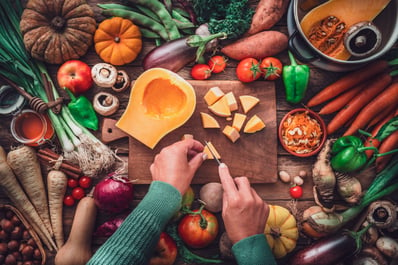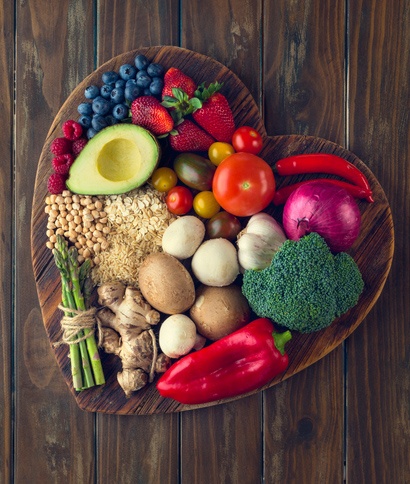 Intuitive eating is the practice of eating in response to your body’s internal hunger and fullness cues, rather than external cues, such as environmental or social triggers that prompt eating behaviors, regardless of true hunger or fullness levels. In today’s society, it is especially difficult to eat intuitively as we are near constantly being bombarded with messaging that tells us what we should or shouldn’t eat and that labels foods as “good” or “bad.” Overtime, as the mind and body become used to ignoring hunger signals, the cues begin to fade and are more and more difficult to notice or may only be noticed when the body is in an extreme, ravenous state, which is likely to lead to overeating, which is then followed by feelings of guilt and desire to restrict based on external cues and continued ignoring of internal hunger cues. For many, the body must be reconditioned, starting with reconnecting with your biological hunger cues. Here’s how to start:
Intuitive eating is the practice of eating in response to your body’s internal hunger and fullness cues, rather than external cues, such as environmental or social triggers that prompt eating behaviors, regardless of true hunger or fullness levels. In today’s society, it is especially difficult to eat intuitively as we are near constantly being bombarded with messaging that tells us what we should or shouldn’t eat and that labels foods as “good” or “bad.” Overtime, as the mind and body become used to ignoring hunger signals, the cues begin to fade and are more and more difficult to notice or may only be noticed when the body is in an extreme, ravenous state, which is likely to lead to overeating, which is then followed by feelings of guilt and desire to restrict based on external cues and continued ignoring of internal hunger cues. For many, the body must be reconditioned, starting with reconnecting with your biological hunger cues. Here’s how to start:
1. Start paying attention to how your body signifies hunger.
The most common and well-known symptoms of hunger include stomach grumbling or growing/gurgling noises; however, hunger may also present as feelings of fatigue or irritability, lightheadedness, and occasionally, with prolonged hunger, even nausea.
2. Before each meal/snack - rank your hunger/fullness on a scale of 0-10. Consider why you are eating - is it for internal reasons or external?
0: Primal hunger - intense and very urgent, may be painful
1: Anxious to eat, ravenous and irritable
2: Very hungry, looking forward to a hearty meal or snack
3: Ready to eat, but no urgency; “polite” hunger
4: Subtle hunger, slightly empty feeling in the stomach
5: Neutral - neither hungry nor full
6: Emerging fullness
7: Comfortably full - satisfied and content
8: Full - not pleasant, but not unpleasant
9: Very full/too full (as if you need to unbutton pants or remove belt)
10: Uncomfortably, even painfully full. May feel nauseated.
3. Aim to eat a balanced meal or snack (protein + fiber + healthy fat) when hunger level is below a 5.
If you are feeling hungry, consider what foods will be most nourishing and what you may have lacked in previous meals (typically fiber or protein).
If you still have the desire to eat despite being >6 on the hunger scale, you may be mistaking true hunger for a different type of hunger, such as emotional hunger, or desire to eat to cope with uncomfortable feelings, or taste hunger, or a desire to eat based on taste or because a food sounds good. It’s OK to eat for taste or comfort on occasion, but for many, due to the years of prolonged suppression of natural hunger cues, practicing portion control in these settings becomes difficult, and overeating often occurs. In these instances, consider other ways to cope with boredom or stimulate the senses that don’t involve food, such as taking a walk, reading a book, calling a friend, lighting a candle, or putting on lotion.
If you’re still struggling with the concept of intuitive eating, how to implement it, or how to identify true, physiological hunger vs emotional or taste hunger, consider reaching out to a dietician for support!

 Adequate energy is needed for all bodily processes, including essential functions like keeping your heart beating, your lungs breathing, and maintaining your body temperature within range, as well as other activities like day-to-day movement and structured exercise.
Adequate energy is needed for all bodily processes, including essential functions like keeping your heart beating, your lungs breathing, and maintaining your body temperature within range, as well as other activities like day-to-day movement and structured exercise.
 As the seasons shift and fall settles in, it’s the perfect time to take advantage of the bountiful seasonal produce that boosts your nutrition and supports an active lifestyle. The cooler weather and fresh produce available at this time of year provide not only a delicious variety but also essential nutrients that help you stay energized, strong, and healthy. Whether you’re training for a race, hitting the gym, or simply maintaining your fitness routine, embracing fall produce can give your body the fuel it needs.
As the seasons shift and fall settles in, it’s the perfect time to take advantage of the bountiful seasonal produce that boosts your nutrition and supports an active lifestyle. The cooler weather and fresh produce available at this time of year provide not only a delicious variety but also essential nutrients that help you stay energized, strong, and healthy. Whether you’re training for a race, hitting the gym, or simply maintaining your fitness routine, embracing fall produce can give your body the fuel it needs.
 Sometimes you might think you’re doing the right things (or at least not really wrong things) when it comes to healthy eating. But those habitual behaviors might actually cause you to consume more food and calories.
Sometimes you might think you’re doing the right things (or at least not really wrong things) when it comes to healthy eating. But those habitual behaviors might actually cause you to consume more food and calories. February is
February is 